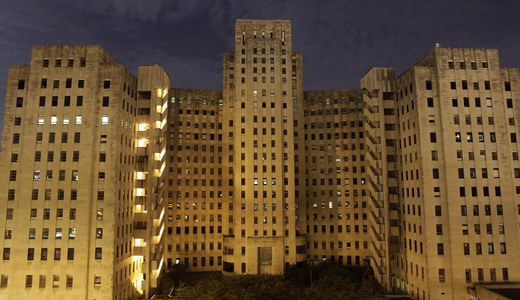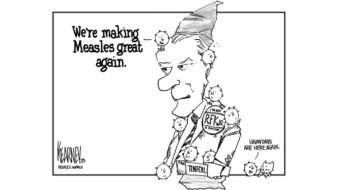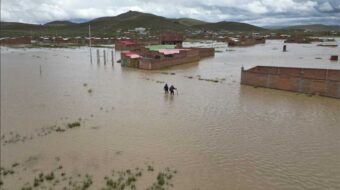
NEW ORLEANS – The ruins of Charity Hospital stand as a reminder of the unimaginable horror that engulfed this city as a result of Hurricane Katrina.
The windowless structure looms as a reminder of the man-made disaster that followed the hurricane – a disaster that prevented the rebuilding of health care facilities here.
The ruins of Charity Hospital, the enormous public health facility that served hundreds of thousands of patients for so many years here, stand today as both a haunting reminder of horrors past and a call to arms for those joining the battle for a restored health care system.
The hospital’s remains overlook the edge of downtown New Orleans, sometimes called the “Isle of Denial” by people who live in other parts of the city. With its hundreds of blown out windows and its tattered ER signs it provides a macabre and scary contrast to the modern office buildings and lively French Quarter just blocks away.
Today, six years after the hurricane, when you peer inside first floor holes that were once windows you see piles of twisted furniture, hospital beds and medical equipment.
You see refrigerators and cabinets marked with biohazard signs that have never been opened since the last human beings fled the hospital six years ago.
“We don’t know what kind of toxic time bomb exists on many of those floors,” said Chet Held, president of Local 130 of the International Brotherhood of Electrical Workers, who took us to view the site.
Held recalled how thousands of hospital patients in New Orleans were trapped by the storm and flood after Katrina slammed into their city.
The power went out first, food ran out next, then medicine and then water.
Doctors and nurses waged a historic, but too often losing, battle to save lives.
Some of the critically ill got out a day after the storm hit, often by boat or helicopter.
Many who were not critically ill when the storm hit became so in the days that followed as they continued to be trapped by the rising floodwaters.
Held choked up as he described what doctors and nurses have told him. “They had to prioritize. They couldn’t save everyone. If a boat or a helicopter came they had to decide. Do the babies go? Do you leave behind the seniors? What do you do?”
A doctor at Memorial Hospital told reporters several weeks after the storm, “Boats were rescuing people from their roofs. People were left to die in the Super Dome, everybody figured that if you were in a hospital you were safe, they forgot about us.”
Makeshift morgues set up in the hospitals began to fill.
Charity Hospital was a public hospital. At some of the private hospitals, boats and helicopters never came.
As the wind gusts approached 100 miles per hour the windows began to break. Later on staff broke the ones the wind didn’t take out as they tried, desperately, to lower the 105-degree temperatures in the patient rooms. They could move patients into the hallways where it was five degrees cooler but they couldn’t move the ones hooked up to oxygen. When the backup generators failed that no longer made a difference.
Water pouring into the torn up roofs cascaded down the walls of the floors below, soaking the carpets in the already steaming rooms.
There was no phone service, not even cell phones.
Nurses, who themselves were on rations of a teaspoon of water every hour, did 12-hour shifts of fanning dying patients with pieces of cardboard in sometimes futile attempts to keep them alive.
“You can’t blame the president for the weather, but with all that how could Bush go on TV talking about what a great job his FEMA director was doing?” Held asked. “It was horrible to see sick people have to fight for their lives that way. Those nurses are heroes.”
“Can you imagine?” Held asked, “how a weak nurse, dying herself from dehydration, felt when she no longer had the strength to fan that patient or hand pump an oxygen machine?”
The lucky were eventually rescued by boat or by helicopters operated by the National Guard.
“That nightmare is over,” said Held, “but now we have to go about the business of rebuilding this whole health care system. Without it, the city really can’t come back.”
Held has long advocated use of state and federal funds to rebuild the hospital. His union members are busy constructing a new 40-bed hospital in neighboring St. Bernard Parish.
“People can’t really come back and rebuild their lives when you don’t have hospitals,” he said.
Our next report on the health care situation in New Orleans will deal with some of the struggles people here are waging as part of that fight.
Photo: The ruins of Charity Hospital stand on the edge of downtown New Orleans. (Colin Gray/PW)











